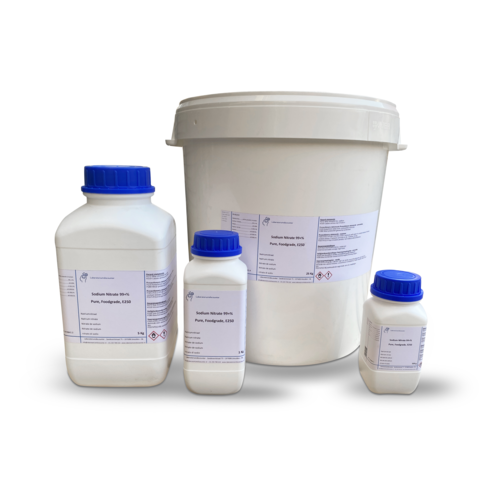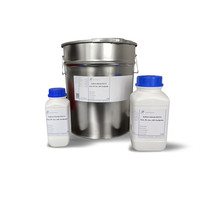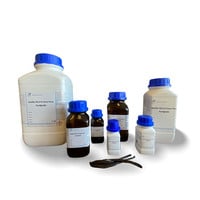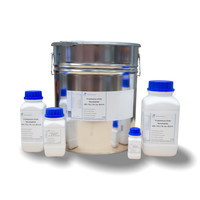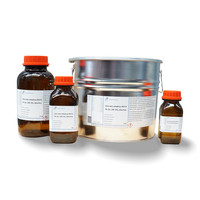You have no items in your shopping cart
Sodium nitrate 99 +%, pure, food grade, E 251
- Buy 2 and save 5%
- Buy 6 and save 10%
What is Sodium Nitrate?
Sodium nitrate (also Chili nitrate), NaNO3, is the sodium salt of nitric acid. The chemical compound is in a pure state in the form of a hygroscopic, i.e. hydrophilic, white substance or colorless crystals.
What is Sodium Nitrate used for?
Sodium nitrate is used responsibly as a nitrogen fertilizer and in food preservation in small quantities for the production of glass or enamel. We also weigh in for pyrotechnic products or solid propellants for rocket engines.
Sodium nitrate is used as a fertilizer, in the building materials industry as a cement additive, as an additive in chemical drain cleaners, as a latent heat accumulator and as a preservative for preserving meat and sausage products. It is also used as a raw material for the production of potassium nitrate.
-Brine salt
Brine salt consists of common salt to which small amounts of sodium nitrate E 251, sodium nitrite E 250, potassium nitrite E 249 and/or potassium nitrate E 252 have been added. The nitrates themselves have no antibacterial effect. However, during the curing process, they are enzymatically converted to nitrites, which are effective against bacteria, especially the botulism pathogen Clostridium botulinum. During this process, the chemically poorly resistant muscle dye myoglobin is converted into a more stable variant (redness). As a result, the meat retains its red color. Uncured meat and sausage products take on a gray color soon after slaughter and the aging process also makes old meat products look fresh. In addition, a typical aroma is created during curing.
Sodium nitrate is used in sausage products, hard cheese, semi-hard cheese, sour herring and sprats.
Nitrates themselves are harmless. Their use is problematic because they are converted to nitrites. This transformation is possible in food, but also in the human body. Nitrites, in turn, have a vasodilator effect and lower blood pressure. At higher doses they can lead to acute symptoms of poisoning (formation of methemoglobin). Nitrite can be converted into highly carcinogenic nitrosamines when meat or milk proteins are absorbed into the human body at the same time.
What Safety Precautions Should I Take Before Using Chemicals?
It is always wise to work as safely as possible when working with chemicals. Even substances that do not seem dangerous at first can cause enormous damage if they get into your eyes. Therefore, always wear safety goggles. You also want to prevent chemicals from ending up on your skin, which is why it is important to always use good gloves or disposable gloves.
Respiratory protection is necessary for volatile substances, vaporous liquids and solids that dust. There are many different types of filters, so you should always refer to the MSDS to find out which filter you need. Many filters also specify which substances they are for.
In some cases it may be necessary to protect the whole body, in which case a plastic overall is needed, you can find it here.
When working with flammable and oxidizing substances, it is important to always have fire extinguishers and absorbents at hand. It is also useful to be able to clean up spills of aggressive chemicals immediately with absorbents and to dispose of them in accordance with international and/or local legislation.
If you need more information on how to handle a specific substance, always consult the safety data sheet. You can find this on the product page or request it via [email protected]
Buy sodium nitrate?
You can buy sodium nitrate that is food grade certified at Laboratoriumdiscounter.nl Delivered quickly and guaranteed the highest quality. Manufactured in Europe to the strictest standards. Buy sodium nitrate for a friendly price at Laboratoriumdiscounter.nl
Technical data
Empirical formula NaNO3
Molar mass (M) 84,99 g/mol
Density (D) 2,26 g/cm³
Melting point (mp) 308 °C
ADR 5.1 III
WGK 1
CAS No. [7631-99-4]
EG-Nr. 231-554-3
UN-Nr. 1498
Downloads
$$$$$
Hazard statements
H272 May intensify fire; oxidiser
H319 Causes serious eye irritation
Precautionary statements
Precautionary statements - prevention
P220 Keep/store away from combustible materials
P280 Wear protective gloves/eye protection
Precautionary statements - response
P305+P351+P338 IF IN EYES: Rinse cautiously with water for several minutes. Remove contact
lenses, if present and easy to do. Continue rinsing
P337+P313 If eye irritation persists: Get medical advice/attentio



